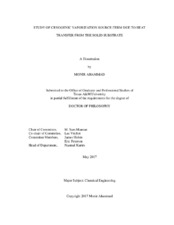| dc.description.abstract | U.S. regulation requires LNG facilities to demonstrate a safe exclusion zone for public safety. European safety case also requires that the facility will demonstrate their risk level within a tolerable limit. Thus, cryogenic liquids (i.e., LNG) release scenarios needs to be modeled to determine consequence severity and perceived risk level. The existing models and tools are very sensitive to the inputs, also known as source-terms. Inaccurate inputs might result in an amplified or subdued consequence severity and may change the estimated risk level and/or safety exclusion zone. Accurate prediction of the source-terms is complex due to the presence of boiling regimes and requires validated models of boiling regimes.
A CFD-based approach is taken to model film boiling using Rayleigh-Taylor instability and volume of fluid (VOF) methods. Film boiling simulations for LN2, LO2, and LNG are conducted with a various degree of wall superheat. The simulated results were compared with Berenson and Klimenko correlations to demonstrate that CFD model overcomes the limitations of these correlations. To extend the applicability of these simulations, a first principle model is proposed to enable a faster calculation of heat transfer to cryogenic pool boiling.
Medium-scale cryogenic spill experiments have been conducted on an instrumented concrete substrate where LN2, LO2, and liquid air are used. The vaporization rate, temperature, and heat flux profiles are recorded during the experiments. It is found that the effect of the mixture on the LN2 vaporization rate is not significant and the heat conduction inside the concrete substrate is unidirectional.
The proposed CFD-based film boiling models for LN2 and LO2 are validated using medium-scale experimental data and are in agreement for higher wall superheats but slightly deviates for the lower wall superheats. The deviation in experimental data can be attributed to the surface roughness and change in boiling regime from film to nucleate. The model for LNG is validated against the experimental data reported in the literature. It is found that the model can capture the vaporization rate reported from the Maplin Sands experiments and other laboratory tests on film boiling. | en |


